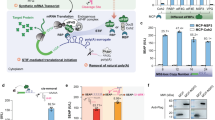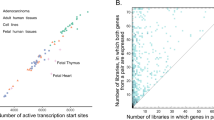Abstract
RECENT work from a number of laboratories suggests that the acquisition of tissue-specific enzyme patterns during embryonic development, and maintenance of these patterns in the adult, probably involves control of the expression of polycistronic operons by specific regulator compounds. These compounds can be recognized hormones1, specific macromolecules2,3, or, quite possibly, metabolic end-products of controlled cistrons. The number of regulator compounds required depends on the complexity of the organism and on the number and size of its operons; it is conceivable that an individual operon may carry instructions for more than one biosynthetic sequence. In this report the role of end-products in establishing tissue phenotypes will be examined.
This is a preview of subscription content, access via your institution
Access options
Subscribe to this journal
Receive 51 print issues and online access
$199.00 per year
only $3.90 per issue
Buy this article
- Purchase on SpringerLink
- Instant access to full article PDF
Prices may be subject to local taxes which are calculated during checkout
Similar content being viewed by others
References
Clever, U., and Karlson, P., Exp. Cell Res., 20, 623 (1960).
Levi-Montalcini, R., and Cohen, S., Proc. U.S. Nat. Acad. Sci., 42, 695 (1956).
Lash, J. W., Hommes, F. A., and Zilliken, F., Biochim. Biophys. Acta, 56, 313 (1962).
Walker, J. B., and Wang, S.-H., Biochim. Biophys. Acta, 81, 435 (1964).
Walker, J. B., Advances in Enzyme Regulation, 1, 151 (1963).
Monod, J., Changeux, J.-P., and Jacob, F., J. Mol. Biol., 6, 306 (1963).
Author information
Authors and Affiliations
Rights and permissions
About this article
Cite this article
WALKER, J. End-product Repression and Tissue Phenotype. Nature 206, 1043 (1965). https://doi.org/10.1038/2061043a0
Issue date:
DOI: https://doi.org/10.1038/2061043a0
This article is cited by
-
Metabolic control of insulin secretion
Acta Diabetologica Latina (1970)



